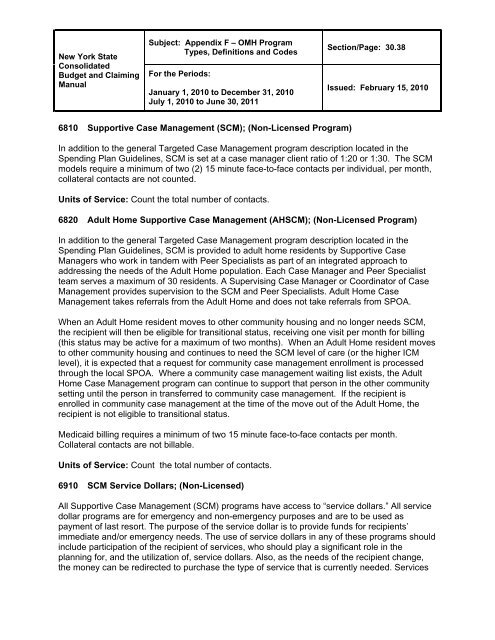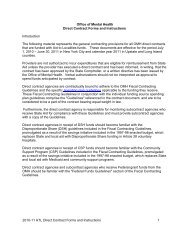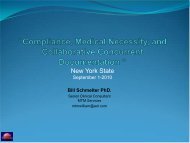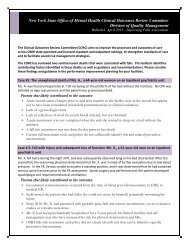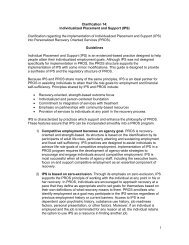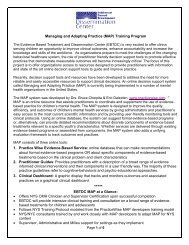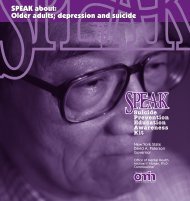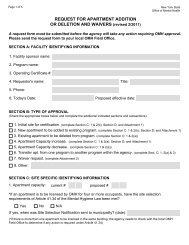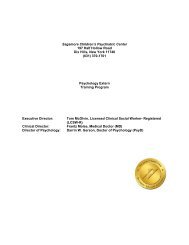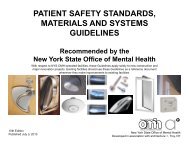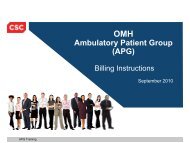Included in CFR Manual Only - New York State Office of Mental Health
Included in CFR Manual Only - New York State Office of Mental Health
Included in CFR Manual Only - New York State Office of Mental Health
You also want an ePaper? Increase the reach of your titles
YUMPU automatically turns print PDFs into web optimized ePapers that Google loves.
<strong>New</strong> <strong>York</strong> <strong>State</strong><br />
Consolidated<br />
Budget and Claim<strong>in</strong>g<br />
<strong>Manual</strong><br />
Subject: Appendix F – OMH Program<br />
Types, Def<strong>in</strong>itions and Codes<br />
For the Periods:<br />
January 1, 2010 to December 31, 2010<br />
July 1, 2010 to June 30, 2011<br />
Section/Page: 30.38<br />
Issued: February 15, 2010<br />
6810 Supportive Case Management (SCM); (Non-Licensed Program)<br />
In addition to the general Targeted Case Management program description located <strong>in</strong> the<br />
Spend<strong>in</strong>g Plan Guidel<strong>in</strong>es, SCM is set at a case manager client ratio <strong>of</strong> 1:20 or 1:30. The SCM<br />
models require a m<strong>in</strong>imum <strong>of</strong> two (2) 15 m<strong>in</strong>ute face-to-face contacts per <strong>in</strong>dividual, per month,<br />
collateral contacts are not counted.<br />
Units <strong>of</strong> Service: Count the total number <strong>of</strong> contacts.<br />
6820 Adult Home Supportive Case Management (AHSCM); (Non-Licensed Program)<br />
In addition to the general Targeted Case Management program description located <strong>in</strong> the<br />
Spend<strong>in</strong>g Plan Guidel<strong>in</strong>es, SCM is provided to adult home residents by Supportive Case<br />
Managers who work <strong>in</strong> tandem with Peer Specialists as part <strong>of</strong> an <strong>in</strong>tegrated approach to<br />
address<strong>in</strong>g the needs <strong>of</strong> the Adult Home population. Each Case Manager and Peer Specialist<br />
team serves a maximum <strong>of</strong> 30 residents. A Supervis<strong>in</strong>g Case Manager or Coord<strong>in</strong>ator <strong>of</strong> Case<br />
Management provides supervision to the SCM and Peer Specialists. Adult Home Case<br />
Management takes referrals from the Adult Home and does not take referrals from SPOA.<br />
When an Adult Home resident moves to other community hous<strong>in</strong>g and no longer needs SCM,<br />
the recipient will then be eligible for transitional status, receiv<strong>in</strong>g one visit per month for bill<strong>in</strong>g<br />
(this status may be active for a maximum <strong>of</strong> two months). When an Adult Home resident moves<br />
to other community hous<strong>in</strong>g and cont<strong>in</strong>ues to need the SCM level <strong>of</strong> care (or the higher ICM<br />
level), it is expected that a request for community case management enrollment is processed<br />
through the local SPOA. Where a community case management wait<strong>in</strong>g list exists, the Adult<br />
Home Case Management program can cont<strong>in</strong>ue to support that person <strong>in</strong> the other community<br />
sett<strong>in</strong>g until the person <strong>in</strong> transferred to community case management. If the recipient is<br />
enrolled <strong>in</strong> community case management at the time <strong>of</strong> the move out <strong>of</strong> the Adult Home, the<br />
recipient is not eligible to transitional status.<br />
Medicaid bill<strong>in</strong>g requires a m<strong>in</strong>imum <strong>of</strong> two 15 m<strong>in</strong>ute face-to-face contacts per month.<br />
Collateral contacts are not billable.<br />
Units <strong>of</strong> Service: Count the total number <strong>of</strong> contacts.<br />
6910 SCM Service Dollars; (Non-Licensed)<br />
All Supportive Case Management (SCM) programs have access to “service dollars.” All service<br />
dollar programs are for emergency and non-emergency purposes and are to be used as<br />
payment <strong>of</strong> last resort. The purpose <strong>of</strong> the service dollar is to provide funds for recipients’<br />
immediate and/or emergency needs. The use <strong>of</strong> service dollars <strong>in</strong> any <strong>of</strong> these programs should<br />
<strong>in</strong>clude participation <strong>of</strong> the recipient <strong>of</strong> services, who should play a significant role <strong>in</strong> the<br />
plann<strong>in</strong>g for, and the utilization <strong>of</strong>, service dollars. Also, as the needs <strong>of</strong> the recipient change,<br />
the money can be redirected to purchase the type <strong>of</strong> service that is currently needed. Services


